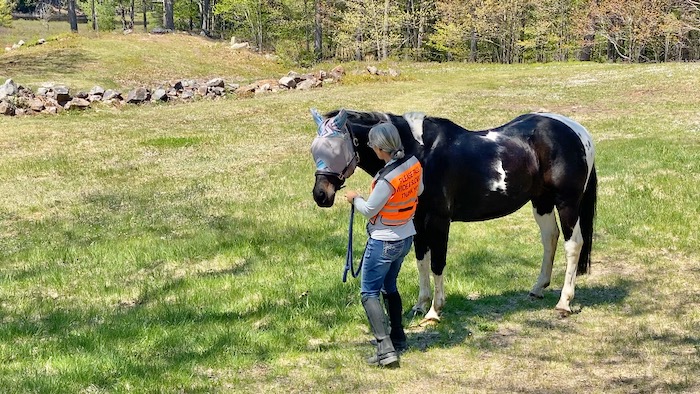Here is how to catch a horse:
Don’t.
I’m not being flippant.
Your horse associates being caught with what comes after. If every time you walk up to your horse the consequence is less rewarding than what they’re doing at the moment, then they’ll keep their distance from you. Are they with their horse friends and you’re taking them to an empty barn? Are they grazing and you’re taking them to a dusty ring? Is your horse relaxing and they know that you’re going to get on and school them in circles? When you arrive in your horse’s field with their lead rope, are you in a rush and have an agenda? If so, there’s no surprise that when your horse sees you that they go to the other end of the pasture.
I want to create other connections in my horse’s mind. I want my approach to be immediately rewarding and I don’t want them to believe that my presence means that life is about to go downhill.
This field is at the front of my house. There are no fences. There’s a marsh in the front and 4,000 wooded acres on three sides. Tonka prefers to stay in the open on the grass, but there’s nothing keeping him from disappearing into the woods. I need to be confident in my ability to catch my horse before letting him free here.

All training starts well before you work on the behavior you’re focusing on. All training with horses also starts from a calm place. I stand quietly with my horse before letting him loose. He continues to stand in a relaxed manner after I unclip the lead rope. Then I let him know with voice and a hand gesture that he’s free to go.

Before you can catch a horse, you have to be able to approach them. I want Tonka to welcome my company. So, after letting him loose, I give him a minute and then go back up to him. I get his attention, pat him and walk away. I do this at his home barn, too. I’ll go out to his field, say hello, and leave. Not catching your horse is what will enable you to catch him later!
After about ten minutes, I went up to Tonka again. You can see how he lets me know he wants to eat by walking away from me. Note some details in this video – I’ve taught Tonka a “head up” cue, so I never have to yank him away from grass. I give him a cookie for doing that. Then I back off from him and ask him to follow a couple of steps. Again, there’s a high-value reward. Then I give him the cue to go back to grazing and I leave. In this way I’ve associated my approach with good things, but I’ve also established some behaviors that I’ll use when actually leading him off of the field.
Even when Tonka gets riled up, he accepts my approach. At Turtle Hill he’s the only horse, and I’m his friend, so he welcomes my input in new situations. Tonka is bold and curious. Rather than going into a panicked flight when there’s something unknown, he goes towards it. I didn’t know what piqued his interest, but when Tonka took off, I joined him. He was happy to discuss it with me. (There’s no cookies involved here, I was putting my phone back in my pocket.)
Tonka showed me what was so interesting. My neighbor and her daughter had come over to take a look. Tonka had met them the last time that we were at Turtle Hill. Once again, I didn’t catch him. After this excitement, he went back to calm grazing and I walked up the hill to the driveway to put my riding gear in the trailer.

When it was time to take Tonka back to his boarding barn there was no problem approaching, clipping on the lead line and walking away. Do you see in this video how I have all of the small components that make this look so easy? I can walk up to my horse without him moving away from me. (Astute viewers will notice the angle that I approach. Walking towards his shoulder keeps Tonka still.) Tonka lifts his head up from the grass when asked – no yanking required. He comes towards me before I have the lead rope attached to his halter. Once in the leading position, he walks willingly and calmly at my side. (There is one cookie provided there, while he’s in motion. But the rest of the way back up the field there is no food given. None needed.)
What at first seems like a simple thing to do – go into the field and catch your horse – is actually built upon many interlocking behaviors. Pay attention to them and make each one understood and worthwhile to your horse, and you’ll have a great relationship with your horse. Pay attention to them and you’ll have that easy to catch horse.



How wonderful Tonka gets to have two wonderful places to wonder!
He does like his outings.
I need to work on one of my mares more often like you do Tonka. I can catch her, but it’s kind of on her terms. I just stand there and give the come signal with my hand, but she walks around for a while and finally comes. If I walk up to her she walks away. I don’t always catch her for something bad, sometimes to hand graze her, sometimes to brush her or whatever. She also knows the head up command. There are two other horses with her, and one of them is really easy to catch, and gets in my way catching my mare. Oh well, I’ll figure it out.
I don’t know if you’ll ever figure it out 🙂 Some horses have thoughts that we’re simply not privy to.